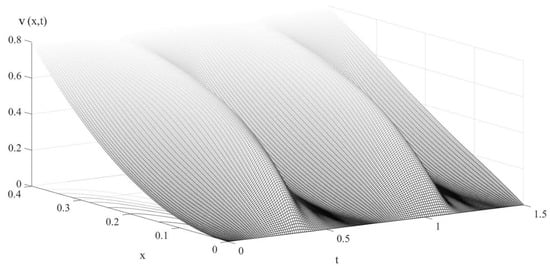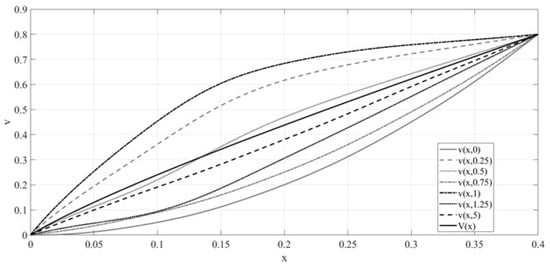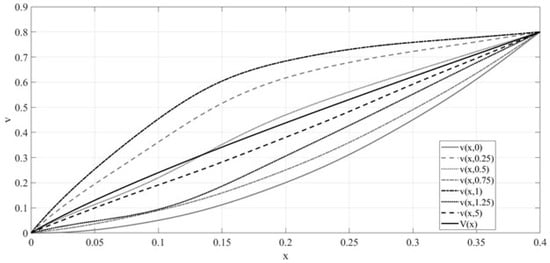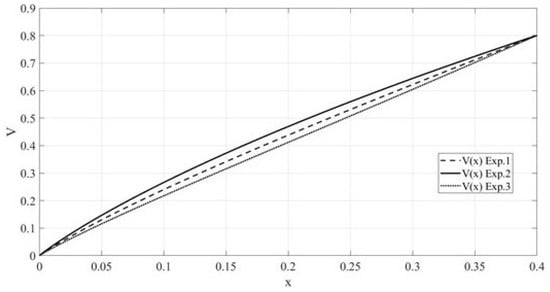Abstract
The paper presents an analytical solution of a partial differential equation of hyperbolic-type, containing both second-order partial derivatives and fractional derivatives of order below the second. Examples of applying the solution of a boundary value problem with stationary inhomogeneities for a hyperbolic-type equation with a fractional derivative in modeling the behavior of polymer concrete under the action of loads are considered.
1. Introduction
Differential equations with fractional derivatives are actively used in mathematical modeling of objects of various nature. The eight volumes of the publication [] present both the main theoretical facts on the theory of fractional calculus and examples of the application of this theory in various fields of natural science. Currently, fractional spatial derivatives are used in mathematical modeling of anomalous diffusions or dispersions, and fractional time derivatives are used to model processes with <<memory>>. In particular, a partial differential equation of hyperbolic-type, containing both second-order partial derivatives and fractional derivatives of order below the second, can be applied to describe the vibration of a string, taking into account friction in a medium with a fractal geometry []. Differential equations with fractional derivatives play an important role in engineering problem solving [,], as well as in physics [,], finance [,] and even in biology [,]. In the present paper, this equation is used in modeling the change in the deformation-strength characteristics of polymer concrete under the action of loads. Particular cases of the problem under consideration can be found in []. The present results are a generalization of the author’s results [].
2. Problem Statement and Solution Method
Let us consider in the domain an inhomogeneous equation of hyperbolic-type containing a fractional derivative with respect to the variable x, that is, equations of the form:
The Dirichlet (or first-type) boundary condition:
Initial conditions:
Here, are constants; is the left Riemann–Liouville fractional derivative (fractional differentiation operator) with respect to a variable x of order :
The problem solution (1)–(4) is found by the standard analytical method for solving hyperbolic equations—the method of separation of variables. That is, the problem solution (1)–(4) is the sum of the two functions:
The physical meaning of the function is a stationary state of the process. This function is a solution of the first boundary-value problem:
The physical meaning of the function is a deviation from the stationary state. This function is a solution to the corresponding homogeneous hyperbolic equation:
with homogeneous boundary conditions:
and initial conditions:
For the functions and from conditions (10), which determine the initial position of the points of the sample and the initial speed of the points of the sample, the following conditions must be met:
The series that will be constructed below for the functions , , and when solving problems (1)–(4) if the above conditions are met, will converge uniformly [], since the fractional differentiation operator of order at most two is subordinate to the second-order differentiation operator .
There
eigenfunctions of the problem:
We use the following notation for the dot product of two functions and :
We find the coefficients and from Formula (11) using the dot product:
The solution to problems (6) and (7) also is found by the analytical method, by reducing to the Volterra equation. A particular case of problems (6) and (7) was considered in []. Now consider the solution of problems (6) and (7) for an arbitrary continuous function . Let us integrate both parts of Equation (6) twice and substitute the boundary condition from (7):
Denote
We obtain the integral equation
This integral equation is an inhomogeneous Volterra equation of the 2nd kind with a difference kernel (a special case of the Fredholm equation). In [], the solution of Equation (15) is written out in terms of a function of the Mittag-Leffler type:
That is,
Let us transform the last expression for the function ,
Let us introduce the notation for the third term:
We simplify the expression for the first two terms of the expression for the function and obtain that
It remains for us to determine the value of the constant G in expression (16). We substitute into the expression (16) and use the boundary condition from (7) to find this constant. Then
We will dwell in more detail on an important particular case, where a time-constant external action—the function —is a polynomial:
In this case,
Consequently,
Notice, that,
In this way:
Finally,
In particular, for we obtain,
3. Results
The results of solving problems (1)–(4), as shown in [,], can be used in modeling the behavior of polymer concrete under the influence of gravity. In this case, the constants in Equation (1) have the following physical meaning: is the viscoelasticity parameter of the medium; c is the viscosity modulus of the medium. As shown in [], for polymer concrete based on polyester resin (dian and dichloroanhydride-1,1-dichloro-2,2-diethylene), the parameter values are:
The function characterizes the external force on the polymer concrete object in the situation under consideration.
We will provide examples in which we set , since such a size is present in the study of various properties of building materials, in particular, in the study of the properties of polymer concrete. The values of the remaining parameters will correspond to polymer concrete based on polyester resin (diana and diacyl chloride-1,1-dichloro-2,2-diethylene).
All calculations were carried out using the high-level programming language MATLAB.
The eigenvalues of problem (13) for were found as zeros of the function:
Note that the case is presented in [], and the case is presented in [].
The graph of the function at for the considered parameter values is shown in Figure 1.

Figure 1.
The function graph for .

Table 1.
The first seven eigenvalues of problem (13) for .
The dot products values at for the first seven eigenfunctions (12) with an accuracy of six decimal places are presented in Table 2.

Table 2.
The dot products values at
The function is taken as an approximate solution:
In calculations, the time step was and the spatial variable step was . When calculating the function of the Mittag-Leffler type, 500 terms were used.
The relation following from (15) will be used as a test of the approximately found function :
Example 1.


Let
In this case,

Figure 2.
The function under the conditions of Example 1.
The values of the constants for checking the accuracy of calculations are:
The relative error is 3%.
Figure 3 shows the graphs of the sections of the function at the time and limit-state function .

Figure 3.
The graphs of the sections of the function at the time and limit-state function in the conditions of Example 1.
Example 2.

Let
The values of the constants for checking the accuracy of calculations are:
The relative error is 0.3%.
Figure 4 shows the graphs of the sections of the function at the time and limit state—function .

Figure 4.
The graphs of the sections of the function at the time and limit-state function in the conditions of Example 2.
Example 3.


Let
The values of the constants for checking the accuracy of calculations are:
The relative error is 4%.
Figure 5 shows the graphs of the sections of the function at the time and limit-state function .

Figure 5.
The graphs of the sections of the function at the time and limit state-function in the conditions of Example 3.
To compare the limit state under the same initial conditions and different external influences, we combine the functions in the same figure under the conditions of Examples 1–3. Figure 6 shows, for comparison, the limit-state graphs under the conditions of Examples 1–3.

Figure 6.
The limit-state graphs under the conditions of Examples 1–3.
4. Discussion
Thus, we have solved problems (1)–(4) by analytical methods and we have given three examples, which can be used in modeling the behavior of polymer concrete under the influence of gravity. We note that, works by [,] considered numerical schemes for solving partial differential hyperbolic-type equations with a fractional derivative. In [], a generalization of the inhomogeneous Equation (1) to the case of an arbitrary external action, but for homogeneous initial and boundary conditions, is considered. In [], approaches from [] are used to solve a homogeneous hyperbolic-type equation with fractional derivatives of two types and with homogeneous boundary conditions of the first kind. In addition, it was shown in [] that the numerical solutions of the equation under consideration coincided with a high degree of accuracy with the solution from the author’s work [] for the corresponding homogeneous equation.
Funding
This research received no external funding.
Data Availability Statement
All data were obtained as a result of computer simulation and this is indicated in the text of the article.
Acknowledgments
The author expresses his sincere gratitude to T. Aleroev and to V. Orlov for useful discussions. The author also thanks the reviewers, whose comments made the article better.
Conflicts of Interest
The authors declare no conflict of interest.
References
- Machado, J.A.T. (Ed.) Handbook of Fractional Calculus with Applications; De Gruyter GmbH: Berlin, Germany; Boston, MA, USA, 2019; Volumes 1–8. [Google Scholar]
- Aleroev, T.S.; Zveryayev, E.M.; Larionov, E.A. Fractional calculus and its application. Preprinty IPM im. M.V. Keldysha [KIAM Preprint] 2013, 37, 25. [Google Scholar]
- Sabatier, J.; Agrawal, O.; Machado, A. Advances in Fractional Calculus. In Theoretical Developments and Applications in Physics and Engineering; Springer: Dordrecht, The Netherlands, 2007. [Google Scholar]
- Aleroev, T.; Aleroeva, H.; Huang, J.; Nie, N.; Tang, Y.; Zhang, Y. Features of seepage of a liquid to a chink in the cracked deformable layer. Int. J. Model. Simul. Sci. Comput. 2010, 1, 333–347. [Google Scholar] [CrossRef]
- Herrmann, R. Fractional Calculus: An Introduction for Physicists, 2nd ed.; World Scientific: Singapore, 2014. [Google Scholar]
- Sandev, T.; Tomovshi, Z. Fractional Equations and Models: Theory and Applications; Springer: Berlin, Germany, 2019. [Google Scholar]
- Sabattelli, L.; Keating, S.; Dudley, J.; Richmond, P. Waiting time distributions in financial markets. Eur. Phys. J. B 2002, 27, 273–275. [Google Scholar] [CrossRef]
- Song, L.; Wang, W. Solution of the fractional Black-Scholes option pricing model by finite difference method. Abstr. Appl. Anal 2013, 45, 1–16. [Google Scholar] [CrossRef] [Green Version]
- Magin, R. Fractional Calculus in Bioengineering; Begell House Publishers: Danbury, CT, USA, 2006. [Google Scholar]
- Yuste, S.; Lindenberg, K. Subdiffusion-limited reactions. Chem. Phys. 2002, 284, 169–180. [Google Scholar] [CrossRef] [Green Version]
- Kirianova, L. Modeling of Strength Characteristics of Polymer Concrete Via the Wave Equation with a Fractional Derivative. Mathematics 2020, 8, 1843. [Google Scholar] [CrossRef]
- Samarskiy, A.A.; Tikhonov, A.N. Equations of Mathematical Physics, 6th ed.; Publishing house of Moscow State University: Moscow, Russia, 1999. [Google Scholar]
- Dzhrbashyan, M.M. Integral Transformations and Representations of Functions in a Complex Area; Nauka: Moscow, Russia, 1966. [Google Scholar]
- Aleroev, T.; Erokhin, S.; Kekharsaeva, E. Modeling of deformation-strength characteristics of polymer concrete using fractional calculus. Iop Mater. Sci. Eng. 2018, 365, 032004. [Google Scholar] [CrossRef] [Green Version]
- Kekharsaeva, E.R.; Pirozhkov, V.G. Mekhanika Kompozitsionnykh Materialov i Konstruktsii, Slozhnykh i Geterogennykh Sred; IPRIM RAN: Moscow, Russia, 2016. [Google Scholar]
- Kirianova, L. The fractional derivative type identification for the modelling deformation and strength characteristics of polymer concrete. Iop Conf. Ser. Mater. Sci. Eng. 2021, 1030, 012094. [Google Scholar] [CrossRef]
- Aleroev, T.; Kirianova, L. Presence of Basic Oscillatory Properties in the Bagley-Torvik Model. In IPICSE-2018 MATEC Web of Conferences; EDP Sciences: Les Ulis, France, 2018; Volume 251, p. 04022. [Google Scholar]
- Zhang, J.; Aleroev, T.; Tang, Y.; Huang, J. Numerical Schemes for Time-Space Fractional Vibration Equations. Adv. Appl. Math. Mech. 2021, 13, 806–826. [Google Scholar]
- Elsayed, A.M.; Orlov, V.N. Numerical Scheme for Solving Time–Space Vibration String Equation of Fractional Derivative. Mathematics 2020, 8, 1069. [Google Scholar] [CrossRef]
Publisher’s Note: MDPI stays neutral with regard to jurisdictional claims in published maps and institutional affiliations. |
© 2022 by the author. Licensee MDPI, Basel, Switzerland. This article is an open access article distributed under the terms and conditions of the Creative Commons Attribution (CC BY) license (https://creativecommons.org/licenses/by/4.0/).